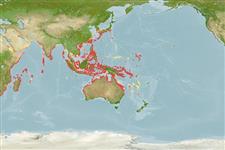>
Blenniiformes (Blennies) >
Blenniidae (Combtooth blennies) > Blenniinae
Etymology: Petroscirtes: Latin, petra, -ae = stone + Greek, skirteo = to jump.
More on author: Valenciennes.
Environment: milieu / climate zone / depth range / distribution range
Ekologi
marina; brackvatten revassocierade; djupintervall 1 - 15 m, usually ? - 10 m (Ref. 48636). Tropical; 22°C - 28°C; 30°N - 30°S
Indo-West Pacific: East Africa to Papua New Guinea, north to southern Japan, south to New Caledonia.
Size / Vikt / Age
Maturity: Lm ? range ? - ? cm
Max length : 11.0 cm SL hane/ej könsbestämd; (Ref. 1602)
Taggstrålar i ryggfenan (totalt): 10 - 11; Mjukstrålar i ryggfenan (totalt): 17-21; Taggstrålar i analfenan 2; Mjukstrålar i analfenan: 17 - 21. Dark, broad stripe from snout through eye to caudal fin; stripe may be broken into segments (Ref. 4404). Highly variable in color and mimics Meiacanthus species (Ref. 48636).
Adults inhabit coastal reefs and estuaries to depths of about 10 m (Ref. 48636). May also be found up to 15 m depth in coastal and lagoon reefs in sandy and weedy areas among clumps of Sargassum or other seaweeds. They also take shelter and nests inside small-necked bottles and abandoned worm tubes or shells (Ref. 90102). They feed on small crustaceans, diatoms, and perhaps other plant material associated with such clumps. They use their fangs defensively and will not hesitate to bite if handled, thus, species of this genus are avoided by predators (Ref. 205). Oviparous. Males uses shells but also ring-top cans for nesting (Ref. 48636). Eggs are demersal and adhesive (Ref. 205), and are attached to the substrate via a filamentous, adhesive pad or pedestal (Ref. 94114). Larvae are planktonic, often found in shallow, coastal waters (Ref. 94114). Mimic of Meiacanthus grammistes, which like all species of that genus possesses a pair of large grooved fangs in the lower jaw with associated venom glands. These bites are used defensively and Papuan variety is also a possible mimic of Meiacanthus vittatus (Ref. 90102).
Life cycle and mating behavior
Könsmognad | Reproduktion | Lek | Ägg | Fecundity | Larver
Oviparous, distinct pairing (Ref. 205).
Myers, R.F., 1991. Micronesian reef fishes. Second Ed. Coral Graphics, Barrigada, Guam. 298 p. (Ref. 1602)
IUCN Red List Status (Ref. 130435)
Threat to humans
Traumatogenic (Ref. 1602)
Human uses
Akvarium: Kommersiell
Ytterligare information
referenserVattenbrukVattenbruksprofilAvelslinjerGenetikElectrophoresesÄrftlighetSjukdomarBehandlingNutrientsMass conversion
MedarbetareBilderStamps, Coins Misc.LjudCiguateraHastighetSimsättGälytaOtolithsHjärnstorlekSyn
Verktyg
Special reports
Download XML
Internet-källor
Estimates based on models
Preferred temperature (Ref.
123201): 25 - 29.3, mean 28.5 °C (based on 2854 cells).
Phylogenetic diversity index (Ref.
82804): PD
50 = 0.5005 [Uniqueness, from 0.5 = low to 2.0 = high].
Bayesian length-weight: a=0.00562 (0.00258 - 0.01228), b=3.06 (2.87 - 3.25), in cm total length, based on LWR estimates for this (Sub)family-body shape (Ref.
93245).
Trofisk nivå (Ref.
69278): 2.1 ±0.2 se; based on diet studies.
Resiliens (Ref.
120179): Hög, lägsta populationsfördubblingstid mindre än 15 månader (Preliminary K or Fecundity.).
Fishing Vulnerability (Ref.
59153): Low vulnerability (10 of 100).
Nutrients (Ref.
124155): Calcium = 141 [64, 242] mg/100g; Iron = 0.758 [0.421, 1.364] mg/100g; Protein = 18.1 [16.9, 19.3] %; Omega3 = 0.0887 [, ] g/100g; Selenium = 21.8 [9.6, 51.3] μg/100g; VitaminA = 114 [30, 410] μg/100g; Zinc = 2.87 [1.87, 4.40] mg/100g (wet weight);
